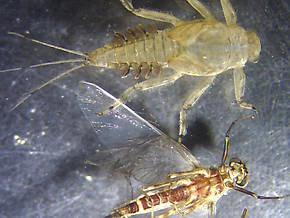Blog & Latest Updates
Fly Fishing Articles
Insects by Common Name


Slate-Winged Olives
Scientific Names
Like most common names, "Slate-Winged Olive" can refer to more than one taxon. They're previewed below, along with 7 specimens. For more detail click through to the scientific names.
Mayfly Species Attenella attenuata
These are sometimes called Slate-Winged Olives.
This intriguing species has received a lot of attention in past angling books. Recent authors suspect that much of this credit was a case of mistaken identity, with Attenella attenuata receiving praise for the hatches of Drunella lata and Dannella simplex. Much of the credit was legitimate and accurate, but this species is no longer thought to be on par with its most popular cousins in Ephemerella and Drunella.
I have several specimens listed under this species, but I'm not positive the identification is correct.
I have several specimens listed under this species, but I'm not positive the identification is correct.
Female Attenella attenuata (Small Eastern Blue-Winged Olive) Mayfly Dun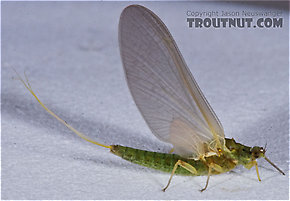 View 4 PicturesThis specimen came from the same hatch as a male.
View 4 PicturesThis specimen came from the same hatch as a male.
 View 4 PicturesThis specimen came from the same hatch as a male.
View 4 PicturesThis specimen came from the same hatch as a male.See 2 more specimens...
Mayfly Species Drunella coloradensis
These are sometimes called Slate-Winged Olives.
This species is very similar to Drunella flavilinea. In areas where their ranges overlap, they can sometimes be found in the same streams. Allen and Edmunds (1962) say that Drunella coloradensis tends to favor colder water than Drunella flavilinea and that it may emerge as much as a month later.
Drunella coloradensis (Small Western Green Drake) Mayfly Nymph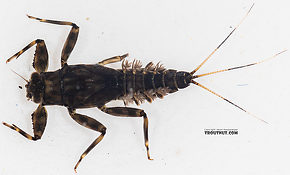 View 11 PicturesThis one nicely illustrates the variation in coloration within an single Ephemerellid species in a single stream, when compared to its lighter, banded counterpart.
View 11 PicturesThis one nicely illustrates the variation in coloration within an single Ephemerellid species in a single stream, when compared to its lighter, banded counterpart.
 View 11 PicturesThis one nicely illustrates the variation in coloration within an single Ephemerellid species in a single stream, when compared to its lighter, banded counterpart.
View 11 PicturesThis one nicely illustrates the variation in coloration within an single Ephemerellid species in a single stream, when compared to its lighter, banded counterpart.Male Drunella coloradensis (Small Western Green Drake) Mayfly Dun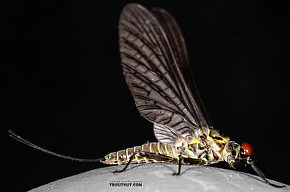 View 8 PicturesThe positive species ID on this dun comes from both the spinner that it (or possibly one other dun just like it) molted into and the overwhelming abundance of nymphs of this species in my kicknet samples from the same site.
View 8 PicturesThe positive species ID on this dun comes from both the spinner that it (or possibly one other dun just like it) molted into and the overwhelming abundance of nymphs of this species in my kicknet samples from the same site.
 View 8 PicturesThe positive species ID on this dun comes from both the spinner that it (or possibly one other dun just like it) molted into and the overwhelming abundance of nymphs of this species in my kicknet samples from the same site.
View 8 PicturesThe positive species ID on this dun comes from both the spinner that it (or possibly one other dun just like it) molted into and the overwhelming abundance of nymphs of this species in my kicknet samples from the same site.Male Drunella coloradensis (Small Western Green Drake) Mayfly Spinner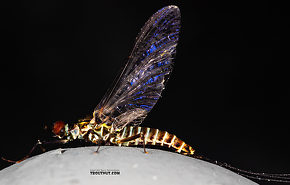 View 9 PicturesThis spinner molted from this dun, or possibly one other dun I had in the same container that looked just like it.
View 9 PicturesThis spinner molted from this dun, or possibly one other dun I had in the same container that looked just like it.
 View 9 PicturesThis spinner molted from this dun, or possibly one other dun I had in the same container that looked just like it.
View 9 PicturesThis spinner molted from this dun, or possibly one other dun I had in the same container that looked just like it.See 7 more specimens...
Mayfly Species Baetis intercalaris
These are sometimes called Slate-Winged Olives.
Mayfly Species Drunella flavilinea
These are very rarely called Slate-Winged Olives.
The Flavs pick up about a week after the closely related but larger Western Green Drakes (Drunella grandis and Drunella doddsii) finish hatching on most Western waters.
Their hatches may be complemented by simultaneous hatches of two less prolific species, Drunella coloradensis and Drunella spinifera.
Their hatches may be complemented by simultaneous hatches of two less prolific species, Drunella coloradensis and Drunella spinifera.
Drunella flavilinea (Flav) Mayfly Nymph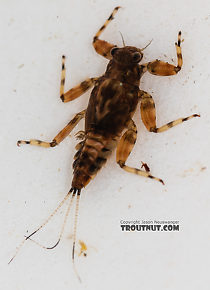 View 6 PicturesAlthough the identification is not certain because the nymph is not yet mature, the configuration of tubercles (
View 6 PicturesAlthough the identification is not certain because the nymph is not yet mature, the configuration of tubercles (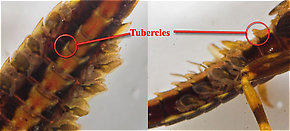 Tubercle: Various peculiar little bumps or projections on an insect. Their character is important for the identification of many kinds of insects, such as the nymphs of Ephemerellidae mayflies.) on this one--particularly the forefemora--seems to best match Drunella flavilinea.
Tubercle: Various peculiar little bumps or projections on an insect. Their character is important for the identification of many kinds of insects, such as the nymphs of Ephemerellidae mayflies.) on this one--particularly the forefemora--seems to best match Drunella flavilinea.
 View 6 PicturesAlthough the identification is not certain because the nymph is not yet mature, the configuration of tubercles (
View 6 PicturesAlthough the identification is not certain because the nymph is not yet mature, the configuration of tubercles (
A few (not all) of the abdominal tubercles on this Ephemerella needhami nymph are circled. They are especially large in this species.
Female Drunella flavilinea (Flav) Mayfly Dun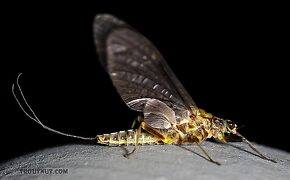 View 6 PicturesI can't be certain of the ID of this female dun, but I'm calling it Drunella flavilinea for three reasons: 1) the known abundance of "flavs" on the Henry's Fork, 2) clear differences in coloration from my confirmed specimens of Drunella coloradensis, which is the main lookalike, and 3) the habitat (a sizable river in a wide mountain valley, rather than a small, high-altitude stream) suggests it's not coloradensis.
View 6 PicturesI can't be certain of the ID of this female dun, but I'm calling it Drunella flavilinea for three reasons: 1) the known abundance of "flavs" on the Henry's Fork, 2) clear differences in coloration from my confirmed specimens of Drunella coloradensis, which is the main lookalike, and 3) the habitat (a sizable river in a wide mountain valley, rather than a small, high-altitude stream) suggests it's not coloradensis.
 View 6 PicturesI can't be certain of the ID of this female dun, but I'm calling it Drunella flavilinea for three reasons: 1) the known abundance of "flavs" on the Henry's Fork, 2) clear differences in coloration from my confirmed specimens of Drunella coloradensis, which is the main lookalike, and 3) the habitat (a sizable river in a wide mountain valley, rather than a small, high-altitude stream) suggests it's not coloradensis.
View 6 PicturesI can't be certain of the ID of this female dun, but I'm calling it Drunella flavilinea for three reasons: 1) the known abundance of "flavs" on the Henry's Fork, 2) clear differences in coloration from my confirmed specimens of Drunella coloradensis, which is the main lookalike, and 3) the habitat (a sizable river in a wide mountain valley, rather than a small, high-altitude stream) suggests it's not coloradensis.Mayfly Species Drunella lata
These are very rarely called Slate-Winged Olives.
When Selective Trout was first published in 1971, Swisher and Richards included Drunella lata (Small Blue-Winged Olive, Slate-Winged Olive) as a Midwestern "superhatch." Although it can also be found in many Eastern trout streams, it is probably more important to Midwestern anglers. Typically a morning emerger, this species often competes for the attention of trout with more abundant Tricorythodes and small baetids during parts of July and August. For this reason, the authors of Selective Trout considered the concentrated evening spinner falls to be more important than the somewhat sporadic morning emergence. From an angling standpoint, this situation is nearly the opposite of the earlier Drunella cornuta emergence in the East, where the morning emergence is usually the main event and spinner falls are often of little consequence.
Currently, Drunella lata shares its name with another mayfly, the former D. longicornis. That mayfly can be important in mountainous areas in the Southeast, but they are larger and the nymphs lack the distinctive pale markings mentioned in the Juvenile Characteristics section. (The information on this page does not describe D. longicornis)
Currently, Drunella lata shares its name with another mayfly, the former D. longicornis. That mayfly can be important in mountainous areas in the Southeast, but they are larger and the nymphs lack the distinctive pale markings mentioned in the Juvenile Characteristics section. (The information on this page does not describe D. longicornis)
Mayfly Species Labiobaetis propinquus
These are very rarely called Slate-Winged Olives.
This species was previously known as Baetis propinquus, a name from older nomenclatures and angling literature familiar to many western anglers. Prior to its current listing, it did a brief stint in the genus Pseudocloeon. The irony is that though this species has hind wings, it was the last species remaining in Pseudocloeon (before the genus recent Nearctic taxonomic demise) which was best known for its species lacking hind wings as an identifying character.
Though it has a national distribution its most important hatches occur in the West, usually hatching between the larger broods of Baetis tricaudatus. Western anglers experiencing a hatch can easily confuse them with the larger Baetis bicaudatus as both nymphs appear similar with only two tails. Besides size, the adults can be separated from bicaudatus (with the help of a little magnification) because L. propinquus lacks acute costal projections (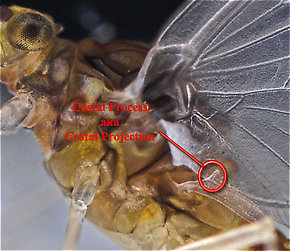 Costal projection: A bump or point sticking up from the front margin of an insect's wing, usually the rear wing of certain mayflies. It is sometimes called a costal process.) on its tiny hind wings. Conversely, the presence of hind wings and lack of conical mesonotal projections (Conical mesonotal projection: small cone shaped spike sticking up from the top and front part of the middle thorax segment.) makes them easy to tell from the more common and equally tiny Acentrella turbida.
Costal projection: A bump or point sticking up from the front margin of an insect's wing, usually the rear wing of certain mayflies. It is sometimes called a costal process.) on its tiny hind wings. Conversely, the presence of hind wings and lack of conical mesonotal projections (Conical mesonotal projection: small cone shaped spike sticking up from the top and front part of the middle thorax segment.) makes them easy to tell from the more common and equally tiny Acentrella turbida.
Though it has a national distribution its most important hatches occur in the West, usually hatching between the larger broods of Baetis tricaudatus. Western anglers experiencing a hatch can easily confuse them with the larger Baetis bicaudatus as both nymphs appear similar with only two tails. Besides size, the adults can be separated from bicaudatus (with the help of a little magnification) because L. propinquus lacks acute costal projections (

The costal projection of a Baetidae dun.
Top 10 Fly Hatches
Top Gift Shop Designs
Eat mayflies.
Top Insect Specimens
Miscellaneous Sites
Troutnut.com is copyright © 2004-2024 Jason
Neuswanger (email Jason). See my FAQ for information about use of my images.
 privacy policy
privacy policy

